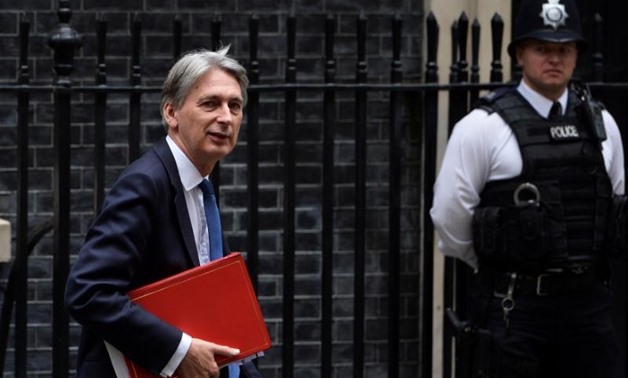
Britain's Finance Minister Philip Hammond leaves 10 Downing Street, London, Britain, October 24 2017. REUTERS/Mary Turner
LONDON -30 October 2017: British finance minister Philip Hammond’s aim to run a budget surplus by the mid-2020s risks being thrown off track next month if official forecasters rein in rosy assumptions about long-run growth, a leading think tank warned on Monday.
Despite borrowing falling to a 10-year low last month, Hammond could need to find more than 50 billion pounds ($66 billion) a year in extra savings by 2021 if he wants to stick to plans he set out in March to cut the budget deficit, the Institute for Fiscal Studies said.
“It is perhaps time to admit that a firm commitment to running a budget surplus from the mid 2020s onwards is no longer sensible,” said Carl Emmerson, deputy director of the IFS, adding that Brexit created further economic uncertainty.
The British government agency which makes budget forecasts, the Office for Budget Responsibility, said earlier this month that it expects to revise down its long-run productivity growth assumptions when it produces fresh forecasts for Hammond’s next budget on Nov. 22.
British economic productivity - the amount produced per hour of work - has stagnated since the financial crisis, and has repeatedly failed to pick up as the OBR has forecast since 2010.
If the OBR assumes that productivity continues to flat-line, then so-called ‘structural’ borrowing - public borrowing adjusted for the economic cycle - would be 69.9 billion pounds in the 2021-22 tax year, up by 53.1 billion pounds from the 16.8 billion pounds forecast in March.
In the more likely scenario that the OBR assumes productivity growth of one percent a year - half its pre-crisis average - then structural borrowing would rise to 35.8 billion pounds by 2021-22, the IFS said.
This would keep Britain’s government on course to meet a medium-term goal of ensuring structural borrowing is below two percent in 2020-21, but would make it hard to reach a longer-term target of a budget surplus by the mid-2020s, the IFS said.
Last week Hammond told parliament he planned to continue with a “measured and balanced” approach to reducing public borrowing in next month’s budget, and officials issued a similar statement on Monday in response to the IFS.
Britain’s overall budget deficit has fallen to 2.4 percent of GDP from 10 percent when the Conservative Party entered government in 2010.
This has mostly been achieved by real-terms cuts in day-to-day government spending on a per-capita basis. Spending on this basis has fallen by 13 percent since 2010, and is forecast to drop by almost five percent more by 2021.
As a result, the IFS said there were “real strains” on public healthcare, where waiting times have risen, and in less visible areas such as prisons, where a shortage of guards has led to increased violence.
Hammond is also under pressure to finance an end to an effective one percent cap on public-sector pay rises and a freeze in benefits for low-paid, unemployed and disabled Britons.

Comments
Leave a Comment